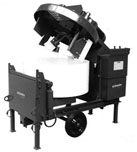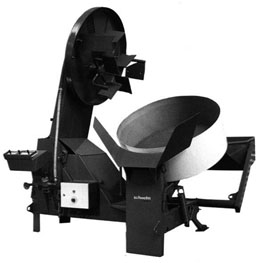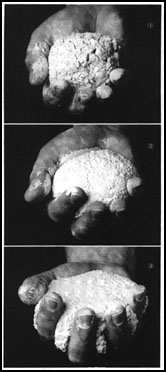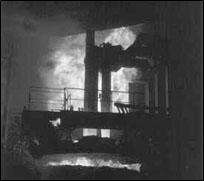Refractorie mixes and mortas
Descriptions
♦ According to application method
- Castable mixes for patching and trowelling
- Castable mixes applied by vibration
- Self-levelling castable mixes
♦ According to binder system
- Castable mixes with cement, traditional
- Low cement castable mixes
- Ultra low cement castable mixes
- No cement castable mixes
|
(CaO>2.5%)
(1.5%>CaO>1%)
(1%>CaO>0.2%)
(CaO<0.2%)
|
|
Raw Materials
♦Metacast-K95, -K97, -K97af
♦Metacast-K95/MA, -K97/MA, -K97/MAc
- Based on tabular alumina and MA-spinel, 92-97% Al2O3
- Suitable for application areas with molten steel contact
- Hot/cold all kinds of repairs
- Low porosity, high strength properties
♦Metacast-B80, -B82, -B82st, -B86c
- Based on high quality bauxite, 80-85% Al2O3
- Tundish permanent lining and high temperature furnance areas
- Metacast-B82st includes stainless steel fibers (10-20 kg/m3)
Low Cement
Castable Mixes
♦Low CaO value due to decrease in cement ratio (1.5%>CaO>1.0%)
♦Decrease in water demand for mixing
♦Castable mixed with water remains workable for a longer period
♦Initial setting of castable starts at temperatures over 15°C
♦High strength properties remain the same till working temperatures
♦Well designed particle size distribution, low porosity and high strength due to less CaO and water content
♦Application areas:
Application
(1) Storing of raw materials
-
Castable mixes are packed dry in
humidity-proof bags of 25kg or 50kg.
-
Shelf-life is approximately 6 months
under dry and rost-proof conditions
of storing.
-
The best way to store castables is in
a ventilated,closed area with room
tenperature of approximately 20°C.
- Unproper storing conditions detoriate
performance of castable mix at
application area.
|
 |
 |
 |
(2) Mixing
-
The castable is preferably mixed
in an intensive mixer.
-
Horizontal pan type, with pallets
and preferably agitators give best
results in mixing.
-
Considering a possible segregation
of the grains, mixing should start dry.
The whole content of the castable bag
is to be poured into the mixer.
-
Only the quantity of castable to
be applied at given period should be
mixed with water.
-
Minimum and maximum water
quantity to be added is mentioned
in using instructions.
|
  |
|
|

|
Water demand and consistency
-
Water quality for mixing should be drinkable, clear, no odor,
co color. Mud, sugar, grease and particles should not be present
in water.
-
Ph value for water should be between 7,0-7,5 and never
less than 7,0. Hardness should be over 2.0°d.
-
Water temperature of 15-20°C improves consistency and
casting properties.
-
Mixing should start with the lowest water addition ratio.
Depending on consistency of the castable, water content can be
increased till to upper limit value.
-
In order to determine consistency some castable is shaped
as a ball in hand.
-
Mixing time is mentioned in using instructions. If mixing time is
hold short, a good mixing is not achieved. If mixing is longer than
required than the castable may get warm and set early.
|
 |
(3) casting into mould under vibration
-
Castable mixes are shaped in stationary steel or wooden templates or moulds. Mould surface shoud
be greased before application.
-
Immediately after casting the mix it is compacted by vibration with use of external or submerged shakers.
-
Submerged vibrators compact the castable by quickly inserting in the castable and slow withdrawal movement.
In case if the vibrator is withdrawn quickly there may occur gaps in the castable and if it is held for a long time
than twister may occur.
-
Vibrators are driven with electricity or compressed air.
-
Choice of vibration frequency may influence coarse/fine grain segregation in the castable. Increasing frequency
may prevent fine grains moving towards mould surfaces.
Vibration equipment
| Submerged vibrators |
Exrernal vibrators |
 |
 |
| Compressed air type external vibrators |
Quick connection parts for external vibrators |
 |
 |
(4) Setting of castable and demoulding
-
Binding time of dense castable mixes is around
2-3 hours depending on environmental conditions,
water added and type of raw material.
-
Depending on wall thickness, room temperature
and material type, it is possible to remove template
or mould after 6 to 12 hours. In contructions like roof
this period should at least be doubled.
-
After demoulding the material should be airdried at
least for 24 hours.
-
Lining to be cast can be structurally strengthened
by suitable anchors. They should be placed with
a disance of approximately 30cm to each other and
the length to be 2/3 of the lining thickness. Generally,
Y-shape anchors are prefered.
|
 |
(5) Drying
- Water in refractory lining may be present in following states;
♦ Free water, inside the pores,
♦ Physically bonded water, inside tiny channels,
♦ Chemically bonded water by hydration,
♦ Hidrate pouch shaped physical/chemical bonded water
♦ Phase change of waterinto steam
♦ Escape of steam by diffusion and flow
-
Drying curve to e applied is given in using instructions of castable mix.
-
Rapid drying may cause explotion due to sudden increase in steam pressure inside the materials.
-
Special additives in dense castables for thick linings may help easier escape of water and risk
of explosion in reduced.
|

- Design and application
of high technology castable mixes
- Right material choice by determination
of user expectations and application areas
- Always cooperate with the user in
production, sales and application...
|
 |
 |













